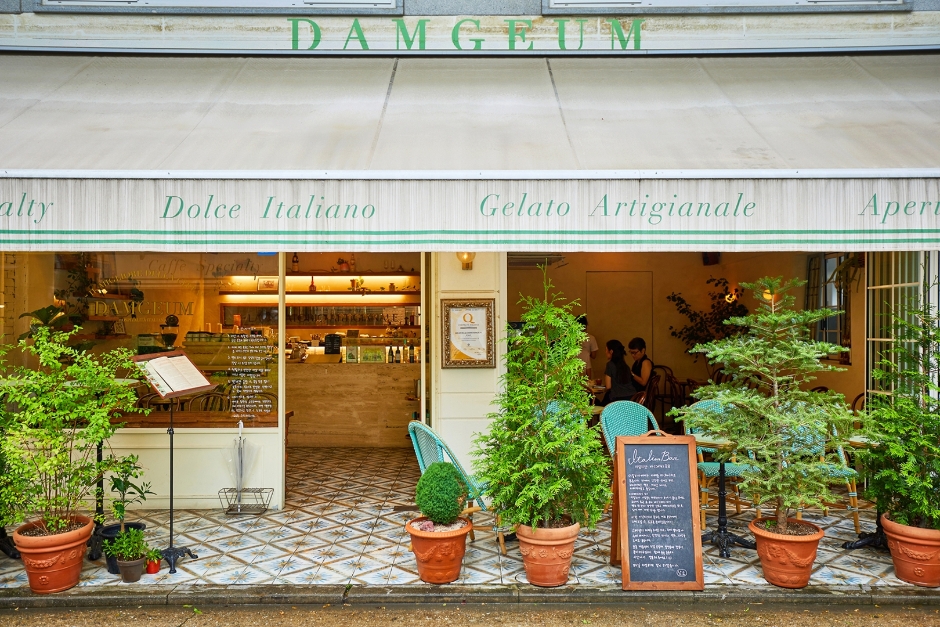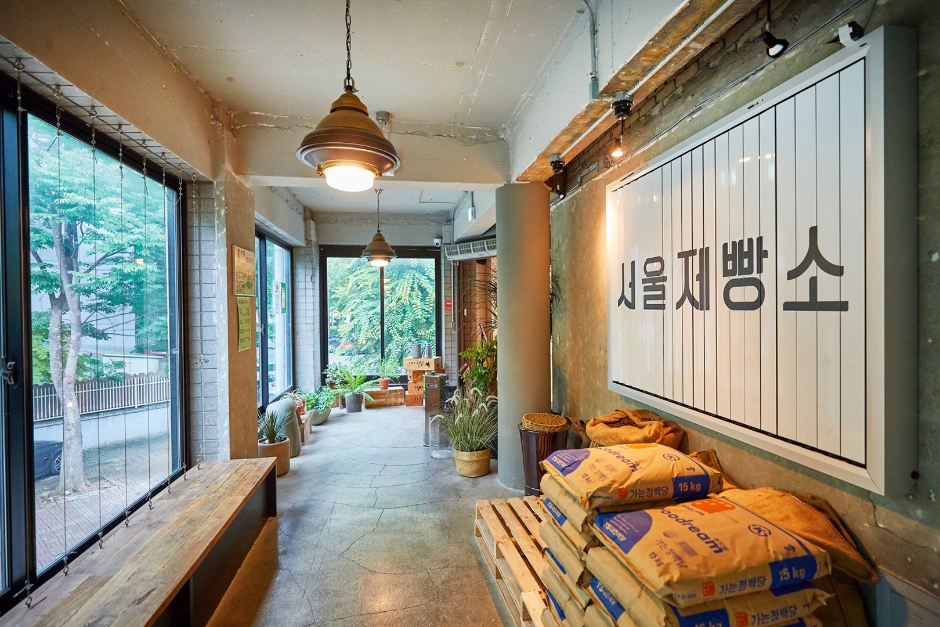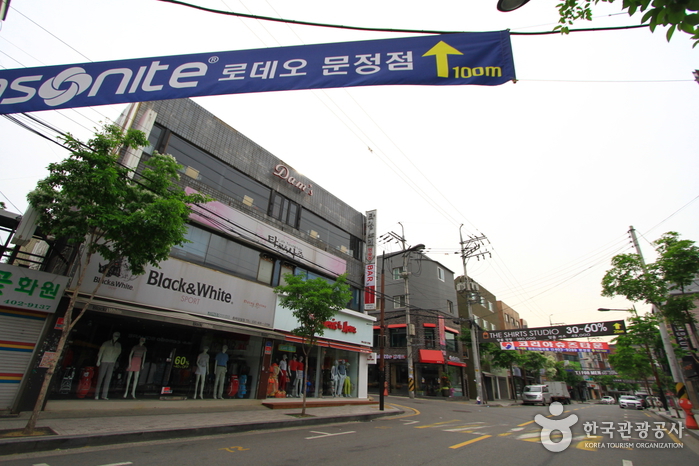Chungmuro Busan Bokjip (충무로 부산복집)
9.8Km 2024-02-28
9-1 Jungdae-ro 27-gil, Songpa-gu, Seoul
+82-2-404-3227
Chungmuro Busan Bokjip is a puffer fish cuisine restaurant situated near Ogeum Park and Olympic Park. The signature menu is the jajubong maeuntang (spicy tiger puffer fish stew), offering a flavorful and refreshing broth made with fresh puffer fish, green onions, radishes, and kelp. Another popular dish is the spicy and sweet bulgogi with fresh puffer fish. Additionally, the bogeo shabu-shabu (puffer fish shabu-shabu) allows diners to enjoy fresh vegetables and puffer fish cooked at the table. Nearby attractions include Seokchonhosu Lake and Lotte World.
Damgeum (담금)
9.8Km 2024-03-26
37 Seongnae-ro 18-gil, Gangdong-gu, Seoul
With its faded white-toned outdoor and indoor interiors and various plants, Cafe Damgeum makes one feel as if they are in a quiet cafe in Italy. The menu includes Italian brunch, dessert, and espresso. Espresso is available in many varieties. Also, this place serves handmade gelato certified by the Italian government, so visitors can enjoy this rich, soft, and delicious Italian dessert. The representative coffee drinks here are espresso and espresso con panna. Espresso con panna has a thick layer of cream on top, allowing one to taste the bitterness of coffee and the sweetness of cream at the same time.
Yeonnam-dong (연남동)
9.8Km 2024-03-19
Yeonnam-dong, Mapo-gu, Seoul
Yeonnam-dong, located near Hongik University Station, has become a hot spot in Seoul as young artists and hipsters gather. It is densely packed with art spaces, and every alley is filled with unique concept cafés and many restaurants. There are also many guesthouses, editorial shops, and fashion stores, along with Yeontral Park, which was transformed from the old Gyeongui Line railroad into a park.
The North Face - Munjeong Branch [Tax Refund Shop] (노스페이스 문정점)
9.8Km 2024-04-19
39, Jungdae-ro 10-gil, Songpa-gu, Seoul
-
Seoul Bakery (서울제빵소 올림픽본점)
9.8Km 2024-03-20
1178 Yangjae-daero, Songpa-gu, Seoul
This bakery cafe is located on the second floor of a commercial wing attached to the Olympic Village Apartments, located across from Olympic Park’s Rose Plaza. The spacious cafe features naturally fermented bread made with organic flour and seats looking out the window. The interior is modern and open, with plenty of seats for long stays. Naturally fermented bread here includes Hongguk rice bread, salt bread, and cream cheese and fig bread. Bread is baked from 08:00 to midday. Visitors can find a timetable for the different kinds of bread served in this cafe in order to make plans in advance to get freshly-baked bread.
E-Mart - Hawolgok Branch [Tax Refund Shop] (이마트 하월곡)
9.8Km 2024-04-22
167, Jongam-ro, Seongbuk-gu, Seoul
-
Olive Young - Cheonho Jungang Branch [Tax Refund Shop] (올리브영 천호중앙)
9.8Km 2024-04-18
1027, Cheonho-daero, Gangdong-gu, Seoul
-
Munjeong-dong Rodeo Street (문정동 로데오거리)
9.9Km 2025-03-29
10, Dongnam-ro 4-gil, Songpa-gu, Seoul
+82-2-400-1633
Munjeong-dong Rodeo Street is a large shopping district containing over 200 brand-name discount stores. The street is T-shaped, with a 1-kilometer-long main street connected to a 400-meter-long alley, and the Munjeong 1-dong Resident Center located at the center. For shoppers’ convenience, there is a public parking lot (if visitors purchase goods at Rodeo Street, they can park here for free) and a parking lot for foreign tourists only (free of charge). Munjeong-dong Rodeo Street is one of Korea’s major shopping streets with customers ranging from teenagers to adults, since discount stores stocking sports wear, casual wear, shoes, men’s and ladies’ suits, and golf wear are all located on this street. Moreover, this is a great place to find deals on famous brands, at prices lower than at a department store. On some items you can get discounts of up to 70-80%.
Since most of the goods are stock from previous seasons, it might be better to purchase the more classic styles rather than the trendy fashions. In some cases, the goods might have been slightly crumpled or stained during the transfer from warehouse storage, but taking them to the dry-cleaners should fix most problems. However you should be careful when looking at the sewing quality, and check for missing buttons.
One more thing to bear in mind is the shopping season. Even discount stores have periods when stock runs low. The best time to shop is immediately after the stores in Rodeo Street restock their merchandise. This is done at about the same time as department stores. There is also an enormous variety of goods to choose from during the Rodeo Festivals in May and September. The purchased goods are exchangeable but non-refundable, so check the quality of the products carefully before purchasing.
In addition, Munjeong-dong Rodeo Street has a wide selection of restaurants and entertainment facilities. There are a number of pizza places, coffee shops, and food courts, as well as internet cafes and game rooms in the alleys behind the stores. Visitors can also relax in the surrounding parks. There’s a park with a 600-year-old zelkova tree right behind the Munjeong 1-dong Resident Center.
Munjeong Rodeo Street is not just a shopping district; it’s a cultural area. The ‘Munjeong-dong Cultural Festival’ takes place every year in May, and the ‘Munjeong-dong Rodeo Festival’ takes place in May every other year. During these festivals, visitors can watch traditional Korean performances, traditional wedding ceremonies, international fashion parades, hip-hop dancing, and more.
A charity sale is held on weekends and national holidays on the open-air stage of the Munjeong 1-dong Resident Center, and merchandise is sold for even bigger discounts.
Hwachang Co., Ltd. - Seoul Branch [Tax Refund Shop] (화창토산 서울)
9.9Km 2024-04-18
212, Yeonhui-ro, Seodaemun-gu, Seoul
-


![The North Face - Munjeong Branch [Tax Refund Shop] (노스페이스 문정점)](http://tong.visitkorea.or.kr/cms/resource/78/2879478_image2_1.jpg)

![Olive Young - Cheonho Jungang Branch [Tax Refund Shop] (올리브영 천호중앙)](http://tong.visitkorea.or.kr/cms/resource/76/2878876_image2_1.jpg)

![Hwachang Co., Ltd. - Seoul Branch [Tax Refund Shop] (화창토산 서울)](http://tong.visitkorea.or.kr/cms/resource/71/2889071_image2_1.jpg)
 English
English
 한국어
한국어 日本語
日本語 中文(简体)
中文(简体) Deutsch
Deutsch Français
Français Español
Español Русский
Русский